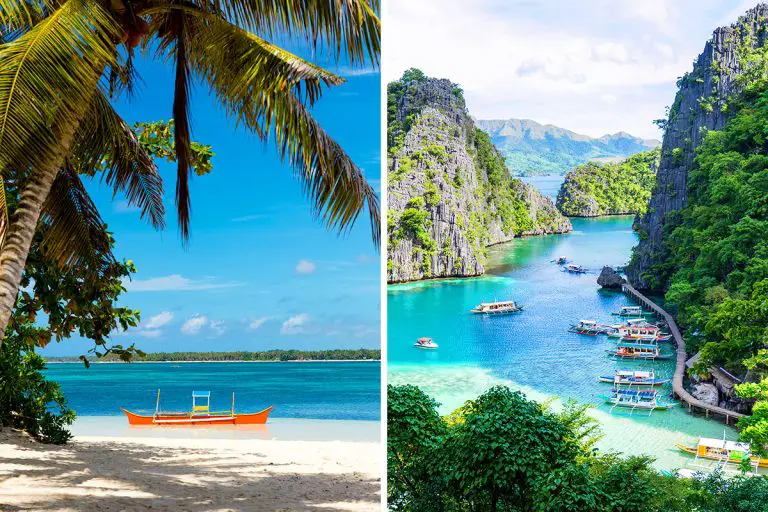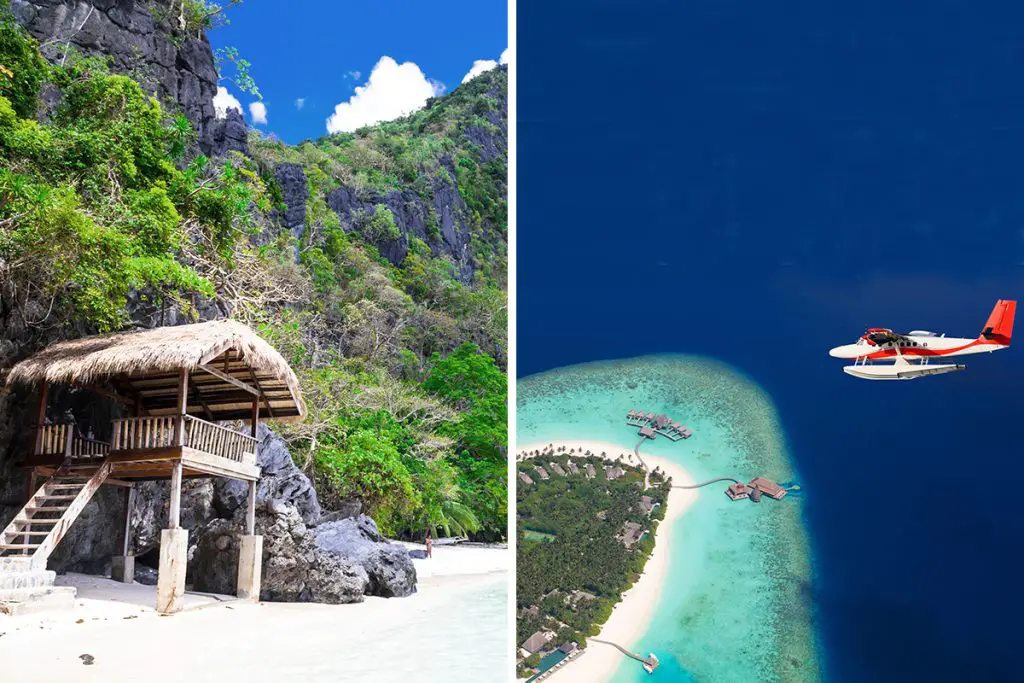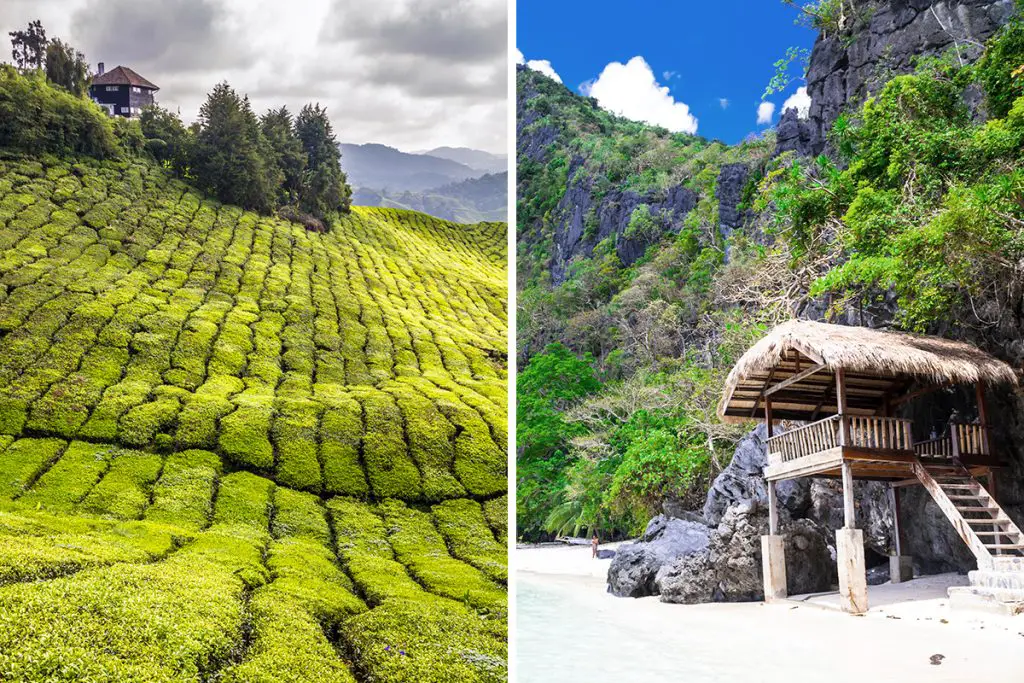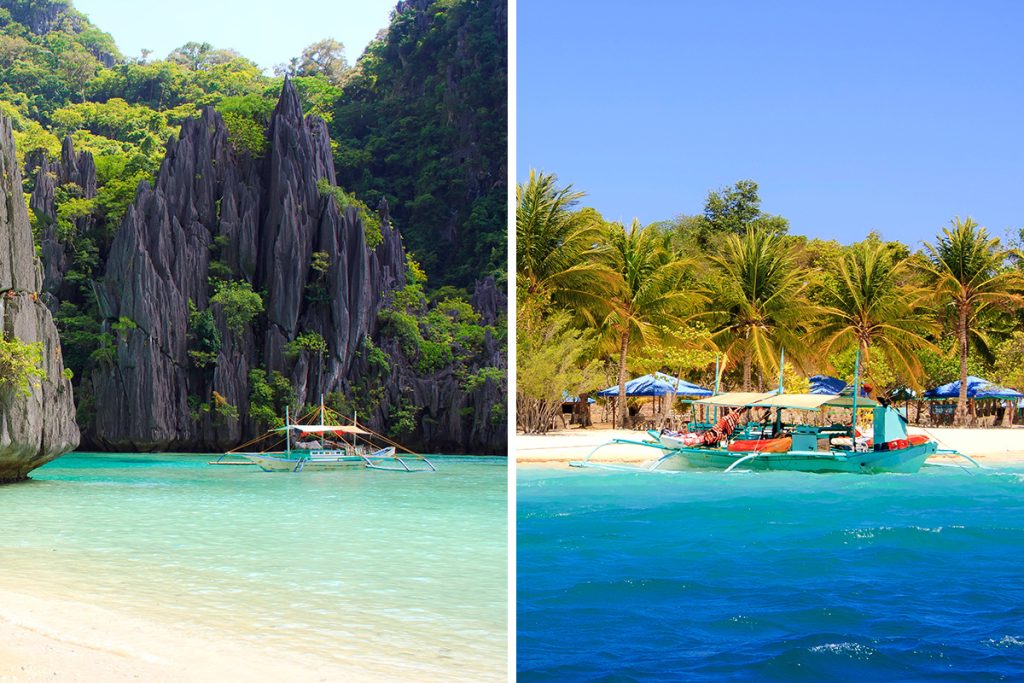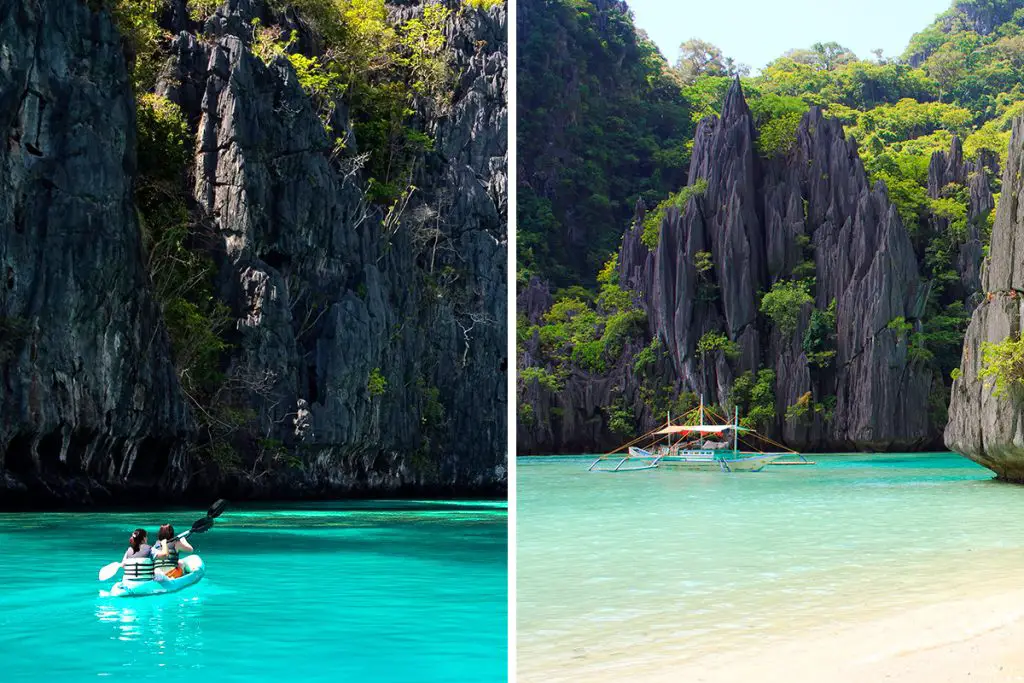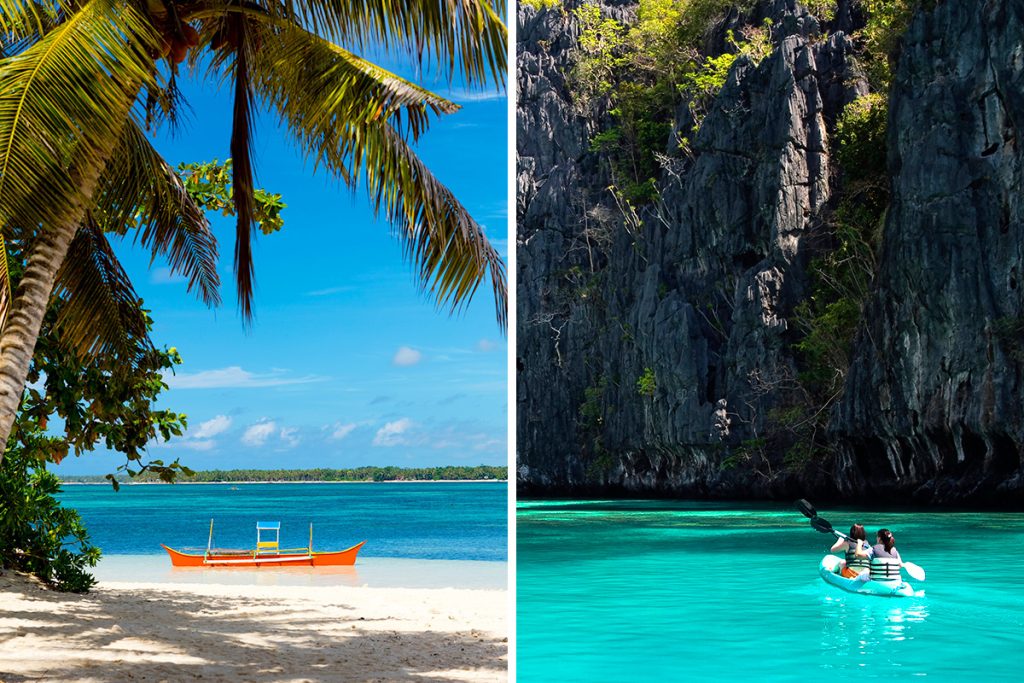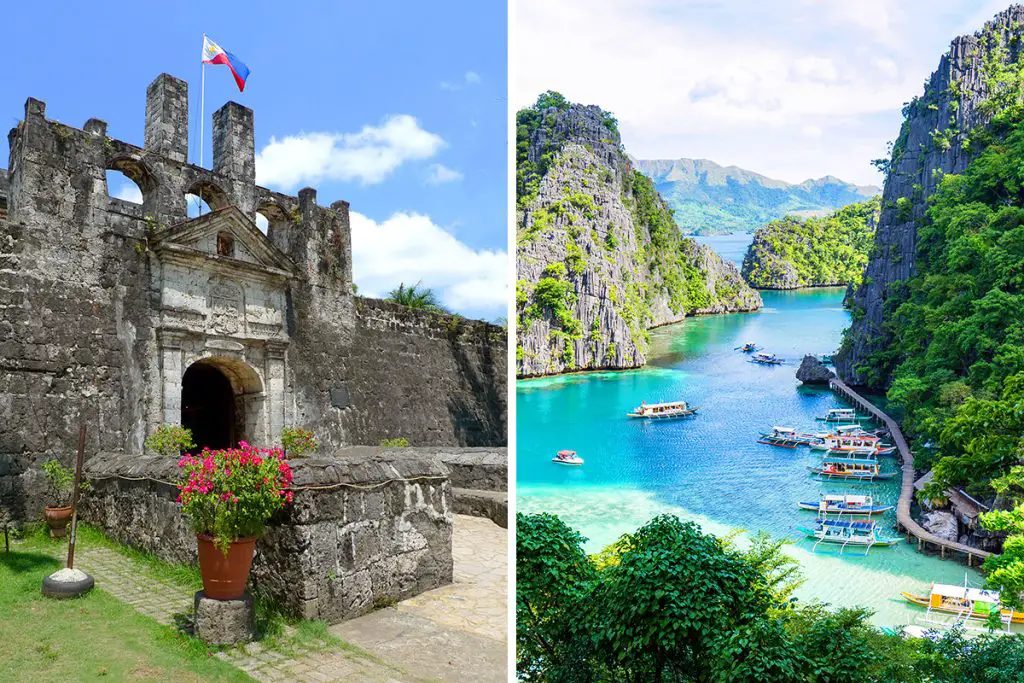Excitement is guaranteed, whether you choose the vibrant Boracay or the tranquil Palawan. Both destinations are overflowing with natural beauty and rich in heritage. So, why not dive deeper? Find out which island resonates more with your travel spirit.
History & Culture
While Boracay and Palawan share a common heritage as part of the Philippines, they offer contrasting historical and cultural experiences.
Boracay, in the past, was a quiet, off-the-beaten-path destination inhabited by the Ati people. Over time, it blossomed into a busy resort island with a vibrant night scene.
Its history is a tale of transformation – from a hidden gem known only to a few to an internationally acclaimed beach destination. This dramatic shift has influenced its culture, which is now a colorful blend of local traditions and international influences.
On the other hand, Palawan, often referred to as the “Last Frontier” of the Philippines, has remained relatively untouched by mass tourism. Its culture is deeply rooted in its indigenous communities, the Palaw’an and Tagbanua tribes, whose traditional ways of life are still evident today.
Palawan’s history is etched into the landscape, from prehistoric cave paintings to World War II wrecks, making it a living museum.
The culture of Boracay is shaped by its tourism industry. It’s a melting pot of cultures, with people from all over the world bringing their customs and traditions to the island. You’ll experience a lively, cosmopolitan vibe that’s unique in the Philippine archipelago.
Meanwhile, in Palawan, culture is closely tied to nature and the sea. Local communities still practice traditional fishing methods and maintain a deep respect for their natural environment. Life here moves at a slower pace, giving you a chance to immerse yourself in a more traditional Philippine lifestyle.
In conclusion, the history and culture of Boracay and Palawan are as diverse as their landscapes. Boracay offers a modern, dynamic culture, heavily influenced by its international visitors. Palawan, in contrast, preserves a more traditional, nature-focused culture, deeply rooted in its indigenous communities. Ultimately, your choice will depend on what you value more in your travel experience: a lively, cosmopolitan vibe, or an immersion in traditional island life.
Attractions & Activities
When it comes to attractions and activities, Boracay and Palawan each offer a unique mix that caters to different interests. Whether you’re an adrenaline junkie or a lover of nature, these two islands will not disappoint.
In Boracay, adventure is always around the corner. Mount Luho, the highest point on the island, invites you for a hike with a rewarding panoramic view at the end. Get your blood pumping with some thrilling watersports such as kiteboarding and parasailing, or discover the island’s lush landscape on an ATV ride.
Palawan, on the other hand, is a nature enthusiast’s dream. A visit to the UNESCO World Heritage Site, the Puerto Princesa Subterranean River National Park, should be on your list. With its impressive limestone formations and diverse wildlife, it’s a spectacle of natural beauty.
You can also try out scuba diving in the Tubbataha Reefs Natural Park, another UNESCO World Heritage Site, known for its coral reefs teeming with marine life.
For the avid history buffs, Boracay may seem like it’s all about the modern attractions, but there’s more to it than meets the eye. A visit to the Boracay Wildlife Expo offers an educational journey through the island’s wildlife. Additionally, the Motag Living Museum provides an interactive experience of the traditional rural life in Aklan province.
Meanwhile, Palawan’s historic landmarks offer a unique insight into the region’s past. Explore the Tabon Caves, known as the Cradle of Philippine Civilization, where artifacts dating back 47,000 years have been discovered. Or visit the Iwahig Prison and Penal Farm, a unique open-air prison where inmates live relatively freely within the farming community.
In summary, while Boracay tends to be more adrenaline-focused, offering thrilling sports and contemporary attractions, Palawan is the go-to for nature lovers and history enthusiasts, with its numerous World Heritage Sites and historical landmarks.
Beaches
Now, let’s talk about what these islands are most famous for – their stunning beaches. Both Boracay and Palawan are home to some of the best beaches in the world, each offering a unique experience.
Boracay’s gem is the White Beach, known for its strikingly fine white sand and crystal-clear water. Stretching around 2.5 miles (4 kilometers), it’s divided into three stations, each with its own charm. Station 1 offers tranquility with high-end resorts, while Station 2 is the vibrant heart of the beach with a bustling scene.
Meanwhile, Palawan boasts a variety of beaches across its numerous islands. El Nido alone has over 50 beaches, each one uniquely beautiful. Nacpan Beach, spanning approximately 2.5 miles (4 kilometers), is famous for its twin beach view, golden sand, and clear blue waters.
For something more secluded, Secret Beach in El Nido is a hidden paradise accessible only through a small hole in a rock wall.
In Boracay, you can also find Puka Shell Beach, known for its abundant puka shells. At about 0.8 miles (1.3 kilometers) long, it’s a quieter escape from the crowds of White Beach. Bulabog Beach, on the other hand, is a haven for kiteboarders and windsurfers, especially during the Amihan season (Northeast Monsoon).
In contrast, Palawan’s beaches offer more variety. Marimegmeg Beach, or Las Cabanas Beach, offers one of the best sunset views in El Nido. Starfish Island, named for its numerous starfish, is a snorkeling paradise, and Seven Commando Beach, accessible only by boat, provides isolation and stunning scenery.
In conclusion, if you’re after a lively beach scene with lots of amenities, Boracay is your choice. If you’re looking for variety and a closer connection to nature, the numerous secluded beaches of Palawan are waiting for you.
Eating, Drinking & Nightlife
Food, drinks, and nightlife play a big part in any travel experience, and both Boracay and Palawan have plenty to offer in this aspect.
Boracay is well-known for its diverse food scene. With eateries dotting the island, there’s a feast to fit any palate. From fresh seafood to Filipino cuisine, Italian dishes to Asian fusion, the choice is yours. You can indulge in a luxe dinner at a beachfront restaurant, or try the local street food at the Talipapa market.
In contrast, Palawan provides a more local dining experience. The seafood is a must-try, caught daily by local fishermen. Many restaurants serve traditional Filipino dishes with a Palawan twist. For a unique experience, try the Tamilok, a local delicacy of woodworm, often eaten raw with vinegar.
Drinks are another part of the dining experience. In Boracay, you can find a wide array of cocktail bars and pubs along the beach. Try the local brews or sip a fresh fruit shake while watching the sunset. Beachfront Happy Hours are popular, where you can enjoy discounted drinks with an ocean view.
Palawan, on the other hand, offers a more laid-back drinking scene. There are several low-key beach bars, perfect for a relaxing evening. Also, don’t miss the chance to try the local Palawan rum and craft beers.
When it comes to nightlife, Boracay is the clear frontrunner. The island is famous for its vibrant night scene, with beach parties, live music, and fire dancers. In contrast, Palawan’s nightlife is more low-key, with a few beachside bars offering live music.
In conclusion, Boracay’s eating, drinking, and nightlife scene is more diverse and vibrant, catering to all tastes and moods. Palawan offers a more traditional and laid-back experience, allowing you to enjoy local flavors and a relaxed atmosphere.
Shopping
Shopping in Boracay and Palawan can be as unique as the islands themselves. From traditional handicrafts to trendy boutiques, each offers a unique shopping experience.
Boracay is a shopper’s paradise. D’Mall in Station 2 is the island’s main shopping hub, offering a mix of local and international stores. Here, you can find everything from beachwear and accessories to local handicrafts and souvenirs. If you’re looking for unique, handmade items, the Crafts of Boracay Supermarket is a must-visit.
On the other hand, Palawan offers a more local shopping experience. The Puerto Princesa Public Market is the perfect place to buy fresh produce and local goods. For souvenirs, the Tiangge-Tiangge Pasalubong Center offers a wide array of handmade items, from woven products to pearl jewelry.
Both islands offer opportunities for purchasing local art. In Boracay, the Habagat Outdoor Shop sells beautiful artworks made by local artists. Similarly, in Palawan, the Kamarikutan Kape at Galeri showcases the artwork and crafts of Palawan’s local artists.
In conclusion, Boracay provides a more modern and diverse shopping experience, while Palawan offers unique local products and handicrafts. No matter your preference, both islands give you the chance to take a piece of your vacation home with you.
Accommodation
Accommodation can make or break a vacation, and both Boracay and Palawan provide a range of options for every type of traveler.
Boracay offers a mix of accommodations to suit different preferences and budgets. Luxury seekers will find high-end resorts such as Shangri-La’s Boracay Resort and Spa or the Lind Boracay. For a more budget-friendly option, there are numerous hostels and guesthouses, like Frendz Hostel Boracay, that offer comfortable and affordable accommodation.
In contrast, Palawan’s accommodation offerings lean more towards nature-centric and eco-friendly stays. El Nido Resorts, for instance, offers four eco-friendly island resorts, each boasting a unique ambiance and view. Budget travelers can opt for guesthouses and hostels, such as Spin Designer Hostel in El Nido or Sheebang Hostel in Puerto Princesa.
Both destinations also have mid-range options. In Boracay, hotels like Coast Boracay and Hue Hotels and Resorts provide modern amenities at a moderate price point. Similarly, in Palawan, mid-range hotels such as Best Western Plus The Ivywall Hotel in Puerto Princesa offer comfortable stays without breaking the bank.
To sum up, Boracay offers a wide variety of accommodation options, from luxury to budget, while Palawan specializes in eco-friendly resorts and nature-centric stays.
Family-Friendliness & Children’s Activities
For families traveling with children, both Boracay and Palawan offer activities that are both fun and educational.
Boracay is a haven for water sports and beach activities. Children can enjoy banana boat rides, paddleboarding, or building sandcastles on the beach. The Boracay Oceanarium offers a glimpse into marine life with its underwater tunnel and sea lion show.
Palawan, on the other hand, presents opportunities for wildlife encounters and nature exploration. The Palawan Wildlife Rescue and Conservation Center, home to hundreds of crocodiles, offers a safe and educational experience. The Butterfly Eco-Garden and Tribal Village introduce kids to the local fauna and indigenous culture.
Both islands also have family-friendly resorts that offer child-focused amenities. In Boracay, resorts like Henann Regency Resort & Spa feature kiddie pools and play areas, while in Palawan, resorts like Astoria Palawan have water parks and kid-friendly activities.
In conclusion, Boracay is great for water sports and beach activities for kids, while Palawan is a perfect choice for families interested in wildlife and nature.
Getting There & Getting Around
Getting to and around Boracay and Palawan involves different modes of transport, each adding to the unique experience of the islands.
Getting to Boracay typically involves a flight to Caticlan Airport (also known as Godofredo P. Ramos Airport), followed by a short boat ride to the island. The total travel time from Manila, for instance, is about 1.5 hours for the flight, plus an additional 30 minutes for the boat ride.
Palawan, on the other hand, is accessible via Puerto Princesa International Airport, with direct flights from Manila taking around 1.5 hours. To reach El Nido from Puerto Princesa, a land journey of about 143 miles (230 kilometers) or approximately 5-6 hours is required.
Once you’re on the islands, getting around in Boracay is easy with the help of tricycles, the main form of public transportation. Alternatively, you can rent a bicycle or take a leisurely walk along the beachfront path.
In Palawan, transportation options include tricycles, rental cars, or vans for longer distances. For the more adventurous, motorbike rental is a popular choice, offering the freedom to explore at your own pace.
To sum up, while both islands are relatively easy to reach with direct flights from Manila, Boracay offers a smaller, more walkable environment, while in Palawan, be prepared for longer land journeys to get from one place to another.
Weather
Tropical weather is one of the prime attractions of both Boracay and Palawan, but their climates do have subtle differences that might sway your preference.
Boracay’s weather can be divided into two main seasons – dry and wet. The dry season, from November to April, is the most popular time to visit. During this period, temperatures average around 82°F (28°C), providing ideal beach weather. The wet season, from May to October, sees more rainfall, but temperatures remain high, averaging 86°F (30°C).
Palawan shares a similar tropical climate but with less pronounced seasonality. The dry season runs from December to May, with temperatures averaging 88°F (31°C). The rest of the year, often referred to as the green season, sees more rainfall, yet the island remains warm with temperatures averaging 86°F (30°C).
Both destinations have their off-peak periods, usually coinciding with the wetter months. However, these periods often offer more affordable travel and fewer crowds, with plenty of sunshine still to enjoy.
In summary, Boracay and Palawan both boast tropical climates with slightly different seasonal variations, but the year-round warm temperatures in both destinations make them excellent choices for beach lovers.
Safety
When planning a trip, safety is a key concern and both Boracay and Palawan take this seriously.
Boracay, being a popular tourist destination, has robust safety measures in place. Local law enforcement is visible, and there’s a dedicated tourist police force to ensure the safety of visitors. However, like in any tourist hotspot, it’s wise to take standard precautions against pickpocketing and to watch your belongings on crowded beaches.
Palawan, although less developed than Boracay, has a reputation for being a safe destination. The locals are known for their hospitality and warmth, and crime rates are relatively low. Nonetheless, due to its vast natural landscapes, it’s advisable to have travel insurance, particularly if you plan on participating in adventure activities.
Unique to both destinations is their commitment to environmental safety. In 2018, Boracay underwent a significant rehabilitation process to ensure the island’s natural resources are preserved. Similarly, Palawan is known as the “Last Frontier of the Philippines” and has strict rules in place to protect its unique ecosystems.
To sum up, while both Boracay and Palawan are generally safe for travelers, always practice standard safety measures and respect the environmental guidelines in place.
Cost
Cost can be a deciding factor when choosing a vacation destination. So how do Boracay and Palawan compare?
Boracay, as a renowned tourist hotspot, can be a bit more expensive compared to Palawan. A meal at a mid-range restaurant in Boracay can cost around ₱700 ($14), while a night in a mid-range hotel can set you back ₱5,000 ($100). For transportation, expect to pay ₱10 ($0.20) for a short tricycle ride.
In contrast, Palawan, being less developed, generally offers lower prices. A meal at a similar mid-range restaurant will cost about ₱500 ($10), and a night in a mid-range hotel can cost around ₱3,000 ($60). A short tricycle ride in Palawan typically costs ₱10 ($0.20), similar to Boracay.
However, prices can vary greatly depending on the season, the specific location, and the type of experience you’re seeking. Remember, exploring off-the-beaten-path destinations or trying local eateries can offer both unique experiences and savings.
In conclusion, while Boracay can be somewhat pricier due to its popularity, Palawan offers a more budget-friendly option without sacrificing natural beauty and unique experiences.
Which Is Better – Boracay or Palawan?
Choosing between two destinations as diverse and vibrant as Boracay and Palawan is no easy task. Each has its own unique allure, shaped by its rich history, cultural identities, and natural attractions.
The history and culture of both Boracay and Palawan are equally fascinating. Boracay’s evolution from a fishing village to a tourism powerhouse provides a glimpse into the adaptability of its local people. In contrast, Palawan’s indigenous tribes, thriving in their ancestral domains, offer a living testament to age-old traditions and customs.
When it comes to attractions and activities, Boracay excels in water sports, thanks to its bustling beach atmosphere. However, Palawan’s lush landscapes and remarkable biodiversity make it the ultimate playground for nature lovers.
The beaches in Boracay are arguably more commercialized but offer a lively vibe, whereas Palawan’s beaches are more serene and secluded, with an untouched quality that’s perfect for tranquillity seekers.
Your food, drinking, and nightlife preferences might tilt the scales as well. If your idea of a great night involves partying until dawn, Boracay’s vibrant nightlife scene could be more appealing. Palawan, on the other hand, offers a more laid-back dining and drinking experience, with its local brews and delicious seafood.
Shopping in Boracay is a more bustling affair, with countless markets and shops offering a wide variety of items. But for those seeking unique, local crafts and produce, the quieter markets of Palawan could be more rewarding.
Similarly, the range of accommodation in Boracay suits every budget and preference, whereas Palawan’s lodging options often embrace a more eco-friendly philosophy.
For family-friendliness and children’s activities, Boracay’s numerous fun-filled activities might be more enticing. Yet, Palawan’s natural parks and sanctuaries can provide educational adventures for kids. In terms of getting around, both destinations have their own charm – Boracay with its tricycles and Palawan with its jeepneys and boats.
The tropical climates in both Boracay and Palawan ensure warm temperatures year-round, but your preferred balance of sun and rain might sway your choice. On the aspect of safety, both destinations make considerable efforts, but always be mindful of your belongings and respect the environmental regulations in place.
Lastly, in terms of cost, Boracay generally comes with a higher price tag, while Palawan offers a more budget-friendly travel experience.
In summary, the choice between Boracay and Palawan ultimately depends on your personal preferences. If you’re looking for a destination that combines lively beaches, bustling nightlife, and a variety of shopping and dining options, Boracay might be your ideal pick. However, if you’re after a more tranquil, nature-centric vacation with opportunities for eco-tourism and exploration of rich biodiversity, Palawan could be the perfect choice.

